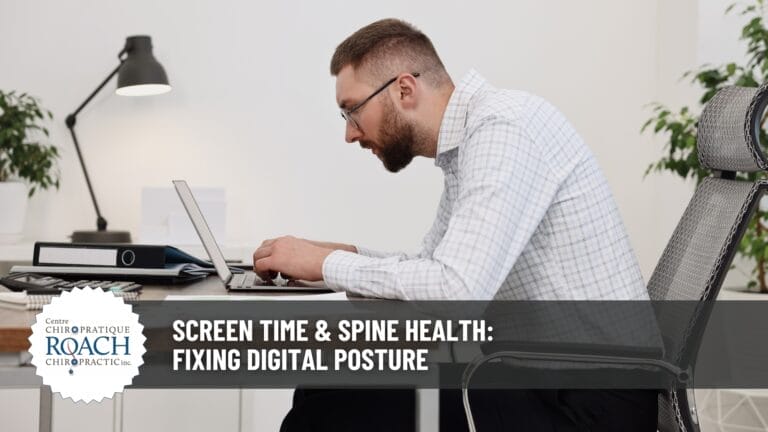Chiropractic for Desk Workers: Undoing the Damage of 9-to-5

Reclaiming Your Spine: Why Desk Workers Need Chiropractic Support
Millions of Canadians spend the majority of their workday seated at a desk. While this sedentary lifestyle may seem harmless, it’s quietly wreaking havoc on spinal health, posture, and overall well-being. This is a call-to-action for anyone feeling the physical toll of prolonged sitting. This issue resonates globally, as desk-bound professionals everywhere grapple with the consequences of modern work habits.
Understanding the Impact of Desk Work on Spinal Health
Desk work often involves repetitive movements, poor posture, and extended periods of sitting – all of which contribute to spinal misalignment and muscular imbalances. Chiropractic care addresses these issues by focusing on spinal health, nervous system function, and musculoskeletal balance. Chiropractors help restore alignment, reduce tension, and improve mobility. This holistic approach not only alleviates pain but also enhances overall function and resilience.
The Numbers Don’t Lie: Desk Work and Musculoskeletal Strain
- Up to 71.9% of office workers experience musculoskeletal disorders, including back pain, neck stiffness, and shoulder tension.
- The average Canadian office worker sits for more than 10 hours a day, contributing to spinal compression and poor circulation.
- Globally, lower back pain affects up to 70% of adults in industrialized nations, with desk jobs being a major contributor.
These statistics underscore the urgency of addressing spinal health in desk-bound populations.
Spotting the Signs: Symptoms of Desk-Induced Spinal Stress
Common symptoms associated with prolonged desk work include:
- Lower back pain and stiffness
- Neck tension and headaches
- Shoulder discomfort and reduced mobility
- Tingling or numbness in the arms and hands
- Fatigue and poor posture
These symptoms can interfere with productivity, sleep quality, and overall quality of life. Left unaddressed, they may evolve into chronic conditions that require more intensive intervention.
Your Desk Recovery Plan: A Step-by-Step Guide
- Schedule a Chiropractic Assessment – Begin with a professional evaluation to identify misalignments and muscular imbalances.
- Adjust Your Workspace – Ensure ergonomic alignment with a supportive chair, monitor at eye level, and feet flat on the floor.
- Incorporate Movement Breaks – Stand, stretch, or walk every 30 minutes to counteract the effects of prolonged sitting.
- Practice Postural Awareness – Maintain a neutral spine and avoid slouching or leaning forward.
- Follow a Chiropractic Care Plan – Regular adjustments and ART sessions can restore alignment and relieve tension.
- Stay Consistent – Healing takes time; consistency is key to long-term improvement.
Stretch, Strengthen, Align: Chiropractic Exercises for Desk Workers
Chiropractic care often includes tailored exercises and stretches to complement in-office treatments. Recommended movements include:
- Seated spinal twists – Improve mobility and reduce stiffness.
- Neck retractions (“chin tucks”) – Counteract forward head posture.
- Shoulder rolls and scapular squeezes – Relieve upper back tension.
- Hip flexor stretches – Combat tightness from prolonged sitting.
- Core strengthening exercises – Support spinal alignment and posture.
Aim to perform these exercises daily, holding stretches for 20–30 seconds and repeating 2–3 times. Proper form is essential—consult your chiropractor for personalized guidance.
From Relief to Resilience: Short and Long-Term Benefits
Short-term benefits:
- Immediate pain relief and reduced muscle tension
- Improved posture and spinal alignment
- Enhanced focus and energy levels
Long-term benefits:
- Prevention of chronic musculoskeletal conditions
- Increased mobility and flexibility
- Better circulation and reduced inflammation
- Improved overall health and productivity
Chiropractic care offers a proactive path to wellness, helping desk workers not only recover but thrive.
Daily Habits That Support Spinal Health
To maintain spinal health and prevent future issues:
- Use a sit-stand desk to alternate positions throughout the day
- Hydrate regularly to support tissue health and circulation
- Sleep with proper spinal support using a quality mattress and pillow
- Avoid crossing legs or slouching while seated
- Incorporate mindfulness and breathing exercises to reduce stress
These routines, combined with chiropractic care, form a powerful defense against desk-related damage.
Why Chiropractic Care Is Essential for Desk Workers
Chiropractic care is uniquely positioned to address the root causes of desk-related discomfort. Unlike temporary fixes, chiropractic adjustments restore spinal integrity, improve nerve function, and promote holistic healing. Various Chiropractic techniques help target muscle adhesions and tension, offering deep relief and improved mobility. For desk workers, this means less pain, better posture, and a renewed sense of vitality.
Healthy desk habits, healthy life habits.
Desk jobs may be unavoidable, but their consequences don’t have to be. Chiropractic care offers:
- Personalised treatment plans
- Non-invasive, drug-free relief
- Preventative strategies for long-term health
- Enhanced physical and mental performance
If you’re feeling the strain of your 9-to-5, chiropractic care could be the missing piece in your wellness puzzle.
Recommended Reading for More Information
Ready to Undo the Damage of Your Desk Job? Roach Chiropractic Can Help
At Roach Chiropractic in Bedford, NS, we specialize in helping desk-bound professionals realign, recharge, and reclaim their well-being. Whether you’re battling back pain or simply want to prevent future issues, our experienced team is here to support you every step of the way.
SHARE THIS






